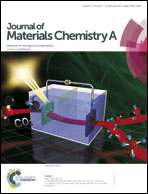Several different charge transfer and Ce3+ localization scenarios for Rh–CeO2(111)
Abstract
We present DFT+U based electronic structure calculations in a p(3 × 3) slab supercell, for low coverages of atomically dispersed Rh interacting with the CeO2(111) surface, comparing Rh as an adatom, and as a dopant substituted into the surface layer. We find that, energetically, a Rh atom approaching a ceria(111) surface with both sparse O and Ce vacancies present strongly prefers to heal the Ce vacancies, but next it prefers to adsorb on a stoichiometric region rather than healing an O vacancy. In the adatom system, Rh is oxidized by electron transfer to a 4f orbital on one Ce ion in the surface layer, which is then nominally converted from Ce4+ → Ce3+ (i.e. Rh adatoms are single donors). We show that there are a number of different local minima, with Ce3+ localization at 1st, 2nd or 3rd nearest neighbour Ce sites. The second neighbour is the most stable, but all are close in energy. In the Rh-doped system (Rh replaces Ce), Rh is oxidized by charge transfer to neighbouring O atoms, and Rh doping leads to deep acceptor and donor states. Rh is not stable in the O sublattice. Moreover, based on vacancy formation energies, we find that oxygen vacancy formation is strongly enhanced in the vicinity of Rh dopants, but slightly suppressed in the vicinity of Rh adatoms.


 Please wait while we load your content...
Please wait while we load your content...